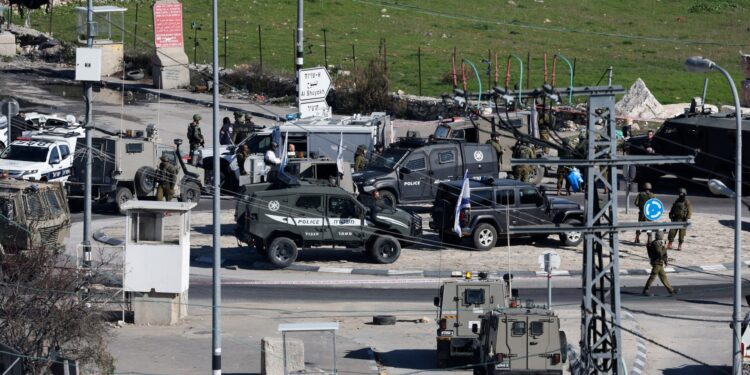If the calls blessed by Israeli Prime Minister Benjamin Netanyahu to re-settle Gaza after its occupation receive a lot of international media attention, then Hebron in the West Bank is effectively and silently occupied, turning the city – which is supposed to be part of the Palestinian state – into the largest laboratory for the occupation. And the Israeli settlement, and its residents live inside a cage, as the “Media Part” website wrote in a report by its correspondent Rashida Al-Azouzi.
“Look, they are watching us. If I talk to you, I will pay the price,” Ahmed (a pseudonym) told the French website’s correspondent, complaining about what he called “life inside a cage.”
He fears not only the settlers, but also the Israeli soldiers stationed meters above and below his house. “Welcome to the heart of hatred. The situation has gotten worse since October 7,” Ahmed concludes his testimony before closing the door to his house.
The graffiti on the walls testify to the truth of what he says, writes Rashida Al-Azouzi. Hate slogans such as “Death to Arabs” and “Gaza must be reoccupied now” fill the walls and doors.
Occupation from within
Hebron, the largest and richest city in the occupied West Bank, was declared by international non-governmental organizations and peace activists to be a symbol of the Israeli apartheid regime.
Cameras, watchtowers, barbed wire, and military observation points surround Hebron, which is the only Palestinian city occupied from the inside, as settlers gather in its center, not in the settlements or settlement outposts around it.
In 1997, the city was divided into two parts after the signing of what was known as the Hebron Agreement (Netanyahu was also prime minister at the time): the first part, “H1”, which is under Palestinian control, and represents 80% of its area, and the second part, “H2”, which is occupied by Israel, and is formed from the historical heart of the city, which dates back to the Mamluk and Ottoman eras.
Here, “800 extremist settlers are disrupting the lives of 35,000 Palestinians, while protecting 2,000 Israeli soldiers,” as an Israeli peace activist from the Media Part website summarizes the situation.
Here, the correspondent adds, the Palestinians who own the place are subject to military law, while the occupying Israelis are subject to Israeli civil law, as documented by many international non-governmental organizations and Israeli human rights organizations, including “Break the Silence.”
In the Old City, the occupation split the Ibrahimi Mosque (which was a purely Islamic place of worship) in half to build a synagogue larger than the original mosque, after the massacre carried out by Baruch Goldstein, the Jewish extremist who killed 29 Palestinians in 1994.
Prayer under bayonets
Jewish settlers come to the synagogue to pray, heavily armed, and enter it through the Israeli-controlled area, while the Palestinians’ crossing is exclusively through the “H1” area, through gates and checkpoints, which also ends with more humiliating security scrutiny at the entrance to the sanctuary itself.
Ahmed lives near Shuhada Street in the Old City, on the way to the tomb of the Prophet Ibrahim, peace be upon him.
The street was the cradle of the first Intifada, and it was bustling with life, but its name changed to “Apartheid Street” after it was emptied of its Palestinian residents due to the Baruch Goldstein massacre.
In the Old City, tension is at its peak, but the situation has been worse and worse since the Al-Aqsa flood.
Facial recognition cameras are everywhere, and the army imposed a complete curfew on residents before loosening its grip a little.
life and death
While H2 is teeming with life and noise, death looms over H1: the streets are deserted, and the houses, windows, and doors are protected by iron bars, windows, and bricks to protect themselves from the stones and waste (and even urine) of the settlers who have begun to settle in the Old City. Early 1970.
“Moving around is very difficult… Checkpoints fill the place, and a short walk to go shopping, go to school, or work in H1 could take you hours,” says a resident who is now seriously considering leaving the area after pledging himself to “resist.” And confronting the attacks and spitting of his settler neighbors.
“Our homes are a prison. If your house overlooks a street forbidden to Arabs, the army closes it to you,” another resident added, “You have to manage your affairs via the rooftops if you want to move around.”
Israel claims that the occupied West Bank is Israeli land according to the testimony of the Torah, and calls it “Judea and Samaria.”
“We are not settling Hebron,” a settler explains to a few soldiers who recently joined the Israeli army, while giving them a history lesson from the top of one of the buildings. “We are only taking back the land that God promised us.”



